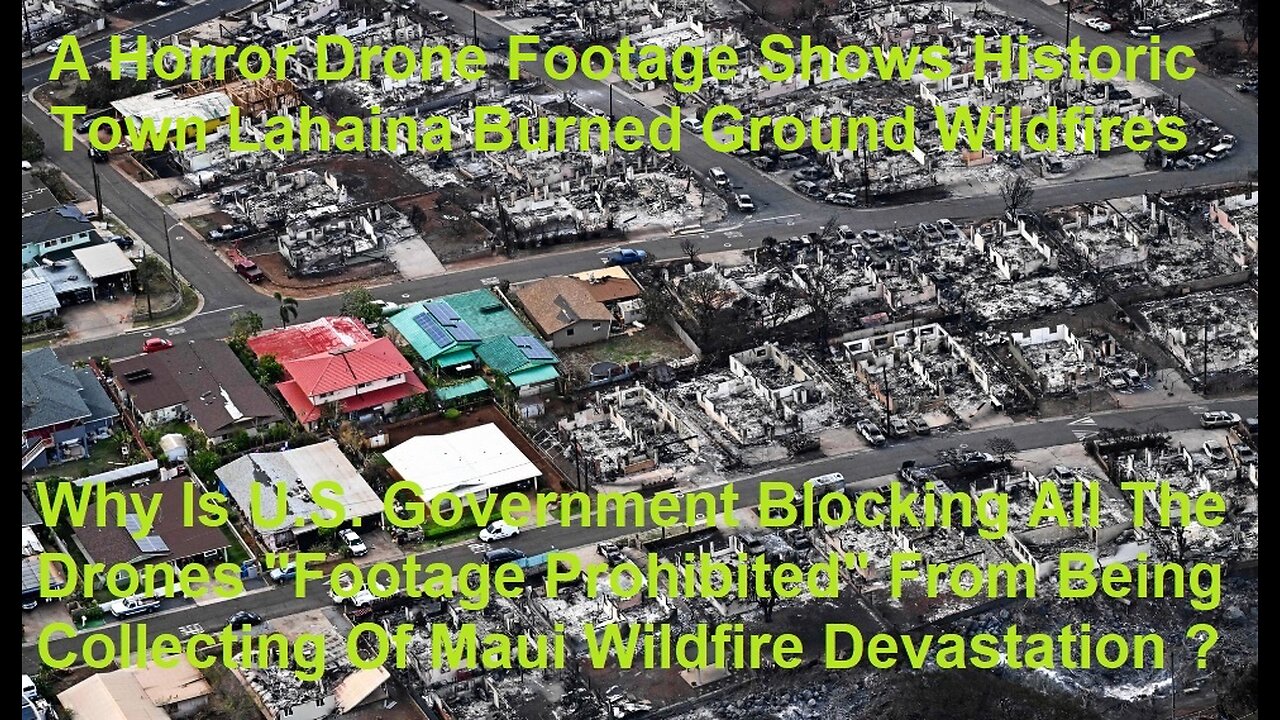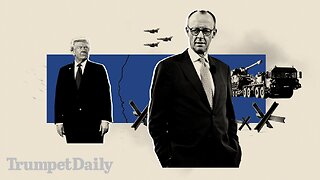Premium Only Content

Why Are Drones Prohibited From Collecting Footage Of Maui Wildfire Devastation ?
Why Is U.S. Government Blocking All The Drones Footage Prohibited From Being Collecting Of Maui Wildfire Devastation ? Drones Are Prohibited From Collecting Footage Of Maui Wildfire Devastation, Raising Concerns About "Intentional Media Blackout" A "volunteer reporter" is on the ground in Lahaina, Maui and is sharing the footage of what he's seeing. But many people are suspecting that there is a "major coverup" happening.
In early August, a devastating wildfire consumed Lāhainā, Maui, resulting in over 100 confirmed deaths and 850 people missing. The event has ignited criticism against Hawaii's state government and Governor Josh Green for perceived inadequacies in emergency response and preparedness. The lack of warning sirens and official response has drawn widespread condemnation. Adding to the tragedy, many children were home alone due to school closures for an unrelated reason, amplifying the disaster's human toll.
Governor Green’s “Anti-Housing” proclamation, aimed at fast-tracking the construction of 50,000 homes on Oahu, has exacerbated public skepticism. Residents worry developers will capitalize on the disaster to build luxury properties, particularly given Maui's existing housing crisis and high average home prices. State Police Chief John Pelletier's history and the federal disaster declaration have not alleviated local concerns; reports indicate minimal assistance post-disaster, including initial restrictions on insulin deliveries.
The situation has been further inflamed by accusations of downplaying the high number of child victims to protect the Biden administration and local Democrats. Over 2,000 children from Lahaina's public schools remain unaccounted for, raising concerns over the actual toll and allegations of a cover-up. Private schools are also impacted, with Maui Preparatory Academy, for instance, seeing a 40% enrollment increase.
Survivors and community members are tormented, believing that better warnings could have saved lives. The disaster has glaringly exposed the deficiencies in emergency preparedness and the need for better coordination in rescue efforts. Despite the monumental social and educational impact, critics accuse officials and media of underreporting the disaster, triggering calls for scrutiny and accountability.
President Biden's visit and comparison of the tragedy to losing his 1967 Corvette in a fire have not helped matters. Public debate is now shifting from recovery to a larger dialogue about governance, accountability, and Hawaii's socio-economic future. Critics are warning against moving on without confronting the consequences of what they view as a preventable tragedy, while the local community remains in mourning, awaiting news of hundreds or possibly thousands of missing individuals.
Accusations of foul play have also emerged.
Accusations of foul play have also emerged, with critics suggesting that officials are not being transparent about the number of children missing or failed to protect residents adequately. Online discourse is filled with disgust toward the handling of the disaster, echoing that mainstream media isn't giving the tragedy the front-page coverage it deserves. Overall, the disaster reveals systemic weaknesses in local governance, preparedness, and media accountability, leading to a collective failure to protect the most vulnerable, and fueling a public debate about the future of Hawaii.
Drones Are Prohibited from Collecting Footage of Maui Wildfire Devastation
However, things may be even worse than what we see. An independent journalist named Geoff Cygnus has been documenting his trip to Maui, where he is attempting to report on this tragedy and its aftermath. He calls himself a "volunteer reporter" and has nearly 400,000 followers on TikTok. On August 17, he announced that local officials shut down their ability to fly drones, which makes many people suspicious about what they might be trying to hide.
"I have been on public property that was not in any way locked down. That's where my footage came from," Cygnus said. But those areas are no longer available for filming.
On Saturday, Cygnus shared some more odd news. "There seems to be a huge emphasis on ensuring that the media and anyone else can't see what's going on here in Lahaina West Maui," he said. He showed "miles and miles of black fence" that is obscuring what's going on on ground zero. Nobody can get in or take any pictures. There are also "weird foreign police cars" that have shown up suddenly that stand guard around the perimeter. "They don't look like any police I've ever seen in the United States," he said.
At one point, he tried to get out of his car to film some footage, but the National Guard yelled at him and told him to get back in his car. "You can't even stop your car" anymore, according to Cygnus. This makes his previous footage all the more unique because there is virtually nobody who is able to capture those photos or videos anymore. Cygnus is curious to find out why there is so much effort ("fencing rocks, police barricades") to blocking off the area where the wildfires were. It begs the question yet again: what are they trying to hide? Cygnus said he essentially gave up his day job to go to Maui and collect footage; he said he has been able to get by because of donations sent to his Zelle account.
When Cygnus' video was shared on X (formerly known as Twitter), Community Notes offered an explanation. Apparently, the Hawaii State Department of Transportation (HDOT) has started installing nearly 30,000 linear feet of dust screen along Honoapiʻilani Highway and the Lahaina Bypass. Maui-based contractors began the month-long project on August 16, and it will cost an estimated $2.4 million. On August 21, HDOT received $3 million in quick-release Emergency Relief funding from the Federal Highway Administration for work like this. The screens reportedly aim to protect highway users and will not interfere with ongoing recovery efforts in Lahaina. HDOT crews will maintain the screens, which will remain in place indefinitely. Access to Honoapiʻilani Highway is limited overnight to residents and first responders.
All the mystery isn't helping anyone.
However, this does not explain why drones are no longer allowed to fly over ground zero to capture footage of the disaster. Many people online are calling this an "intentional media blackout" in order to ensure a "major coverup." But there are some other takes online that show another possible side.
"Honestly, IMO it’s not secrecy. It’s respecting those families still looking for loved ones. People don’t need to go tracking through all the ashes to make money on their Zelle Accounts," @LouMerrijul wrote on X.
All the mystery isn't helping anyone, though. Despite the explanations for the black wall going up around ground zero, most people are concerned with the level of secrecy that has shrouded these devastating wildfires.
Timeline: How ferocious wildfires devastated Maui, hour by hour NBC News has reconstructed a timeline of events in Hawaii, where windswept wildfires ravaged communities and killed scores of people.
Monstrous, windswept wildfires ripped through the Hawaiian island of Maui last week, charring communities and killing at least 100 people. NBC News reconstructed a timeline of events based on public advisories, state government warnings, eyewitness accounts and videos posted on social media. Note: All times are local.
Monday, Aug. 7
9:52 a.m.: Hawaii’s Emergency Management Agency (EMA) warns residents about winds whipped up by Hurricane Dora and other potentially dangerous conditions. “Red Flag Warning is in effect for leeward areas of Hawai‘i,” the agency says in a post on X, the platform formerly known as Twitter, “with low humidity, gusty winds and dry fuels creating risk of extreme fire behavior.”
Tuesday, Aug. 8
3:45 a.m.: Maui officials announce in a news release that a brush fire was reported in the Olinda Road area of Kula, an area in central Maui. The blaze would come to be known as the Upcountry Fire.
6:37 a.m.: Dora-fueled winds help create conditions for a 3-acre brush fire that breaks out in the area of Lahainaluna Road, east of the historic seaside town of Lahaina.
9 a.m.: The brush fire in Lahaina is declared “100% contained” shortly before 9 a.m., according to the Maui officials. But that does not mean the blaze is fully extinguished. In a news release, Maui officials say “power outages are impacting the ability to pump water.”
11 a.m.: Gayle and Ross Hart, a couple in their 70s, see the fire cross a gulch near their neighborhood in Kula. Eventually, their water pressure gives out and they are forced to leave. The blaze consumed their house. “The only thing standing is our mailbox,” Gayle later said.
3 p.m.: Explosions are heard by one Lahaina resident, who describes a series of “boom, boom, boom” sounds on his street and later posts a video to Instagram.
3:30 p.m.: The fire in Lahaina flares up, forcing the closure of the Lahaina Bypass. Fire crews spend the afternoon battling blazes in both Kula and Lahaina, and officials urge evacuations.
3:43 p.m.: The EMA posts on X that Hawaii Lt. Gov. Sylvia Luke — serving as acting governor while Gov. Josh Green travels out of state — has issued an emergency proclamation.
5:38 p.m.: Smoke surrounds boats at Lahaina Mooring Field, according to a video later uploaded to Instagram. “People are trapped — boats, cars & gas stations are exploding. Everything is burning,” the Instagram user writes. “Please just pray.”
5:41 p.m.: The fire encroaches on a retail area in Lahaina as jet-black plumes of smoke billow in the air, according to video recorded at the scene by Lahaina resident Alan Dickar. “The smoke was thick [and] blocked out the clear, blue sky,” Dickar would later say in a Facebook post.
6:30 p.m.: At the Aina Nalu condos in Lahaina, a group of people in a swimming pool watch as massive flames annihilate the surrounding buildings, according to video recorded at the scene.
7:03 p.m.: Flames ravage the Lahaina harbor and explosions are heard every few seconds amid the rush of fierce winds, according to video recorded by Lahaina resident Bryan Sizemore. “I saw at least a dozen bodies floating in the water,” Sizemore later tells NBC News.
9:45 p.m.: Maui County Mayor Richard Bissen’s office says he’s issued an emergency proclamation in response to the fires.
In a Facebook post late Tuesday, Maj. Gen. Kenneth Hara, adjutant general of the Hawaii National Guard, announces that his military force has been activated. “This support was accelerated because of the rapidly changing conditions tonight,” Hara wrote.
Wednesday, Aug. 9
9:25 a.m.: Maui officials say in a news release that four helicopters are assisting firefighters in Lahaina.
The same day, the County of Maui announces that six people have been found dead.
Charlie Newman, a student at the University of Chicago who has been visiting his parents in Maui, tries to get out of the area but encounters “just a mass exodus of people, just inching along the highway, parked on the side of the road.” (He eventually makes it to the airport.)
The Federal Emergency Management Agency, meanwhile, approves fire assistance grants for the Lahaina fire, the Upcountry fire and other blazes on the island.
3:30 p.m.: Maui officials confirm that a federal team arrived on the island to “assist with search and rescue efforts.”
Officials later announce that “36 total fatalities” have been discovered amid the Lahaina blaze.
President Joe Biden says in a statement that he has “ordered all available Federal assets on the Islands to help with response.”
Dr. Reza Danesh, an emergency doctor, spends 14 hours driving people to evacuation shelters, treating them in a mobile medical clinic and helping triage evacuees. He treats a woman who was covered in burns. She tells him that she had jumped into the ocean to avoid the flames.
Thursday, Aug. 10
7:30 a.m.: Drone video later uploaded to Facebook captures the utter devastation in Maui: charred buildings, scorched palm trees, ash-strewn streets, the waterfront bathed in a sickly haze.
10:30 a.m.: The fire in Lahaina is reported to be 80% contained, and another fire in the Pulehu/Kīhei area is said to be 70% contained. Officials do not say how much of the Upcountry blaze has been contained.
1:10 p.m.: Maui officials announce in a news release that 17 additional fatalities have been discovered, bringing the death toll to 53.
9:15 p.m.: The death toll rises to 55 people as officials say that two additional fatalities were found.
Friday, Aug. 11
1 p.m.: Maui officials confirm 12 additional fatalities were discovered. The death toll rises to 67 people.
In a statement that day, the EMA confirms that “neither Maui nor HI-EMA activated warning sirens on Maui during the wildfire incident.”
3 p.m.: The Lahaina fire is 85% contained, the Pulehu/Kihei fire is 80% contained, and the Upcountry fire is 50% contained. “Firefighters continue battling flare-ups in all three fires,” Maui officials say in a news release.
Saturday, Aug. 12
The Pulehu/Kīhei fire is declared “100% contained.”
2:05 a.m.: Maui officials say the death toll stands at 80 people.
Sunday, Aug. 13
9 p.m.: The Maui Police Department says there are 96 confirmed fatalities.
Monday, Aug. 14
10 p.m.: Police say there are 99 confirmed fatalities. Maui officials say about 25% of the area has been searched.
Horror drone footage shows historic town of Lahaina burned to ground after devastating wildfires. The death toll from the Maui wildfires has risen to 106 but is expected to increase as searchers continue to look for at least 1,000 people who are still missing.
Chilling drone footage captured over the weekend showed what was left of Lahaina, the historic town that was incinerated when wildfires ravaged the Hawaiian island of Maui.
All that was left of the razed neighbourhoods were smouldering ruins as some residents returned to survey the destruction.
The death toll from the Maui wildfires has risen to 106, Hawaii Governor Josh Green confirmed, but the number is expected to increase as searchers continue to look for at least 1,000 people who are still missing.
The grim figure makes the tragedy the deadliest wildfire in the US since 1918 and officials have said the true scale of casualties remains unclear.
The fire was about 85 per cent contained earlier this week, after burning an estimated 2,170 acres, according to the County of Maui.
Specialist search dogs from the Federal Emergency Management Agency’s Urban Search and Rescue teams have now joined the harrowing searches for victims.
The dogs and their handlers have taken on the distressing job of searching through the ruins to identify human remains.
Mr Green is asking those with missing family members in Maui to submit a DNA test to help identify the victims.
“We’re asking all of our loved friends and family in the area who have any concern to go get swabbed at the family support center so that we can match people genetically.
Drone Laws Maui (How To Register And What Are The Rules) While drones may include consumer and commercial applications, there are many distinct differences between them. And while the general definition of a drone may not carry much significance, it is critical to know the law as it applies to your intended use. In this article, we will take a look at Federal drone laws Maui and how they will apply in different situations.
Drones are not allowed within 5 miles of any airport. They cannot be flown over or above crowds, or over private property without the owner’s permission. The FAA requires that all drones be registered with them, and that you keep your registration number on your drone at all times.
Drone Laws Maui Maui Is A No-Fly Zone For Commercial Drones And Maui Is A No-fly Zone For Commercial Drones. In fact, it’s a no-fly zone for all drones except those used by the military and law enforcement agencies.
There are two exceptions to this rule:
If you’re working on your own property and you have permission from the landowner to fly your drone there, then you can go ahead and do so—but please make sure that they know what they’re getting into first before giving them permission! It’s always best to have both parties sign an agreement stating exactly what will happen if something goes wrong (like crashing or being stolen).
If you have an FAA waiver or experimental certificate allowing you to operate experimental aircraft in Hawaii—then as long as it’s within those parameters, then yes! You can fly your drone here.
Parks And Other Public Recreation Areas Are No-Fly Zones
The FAA has issued different rules for commercial and noncommercial drone use. Commercial drone users are required to get a special license from the FAA, and noncommercial drone users must follow certain guidelines. Both types of drone use are prohibited in parks and other public recreation areas unless specifically permitted by local authorities.
If you’re flying a noncommercial drone, remember that you must be at least 16 years old (or younger if accompanied by an adult). If your aircraft weighs more than 55 pounds, it must be registered with the FAA before taking off.
Drones Cannot Be Used Within Half A Mile Of Shorelines
It is illegal to fly drones within half a mile of shorelines. This law helps protect marine life and the privacy of beachgoers.
This includes all public beaches, except for those designated by the county as “no drone zones”. These no-fly zones include popular beaches such as Wailea and Kihei, as well as Turtle Bay Resort on Maui’s North Shore. It also includes many boat launching areas like Kahekili Beach Park and Waihee boat ramp.
Drones Are Prohibited From Flying Over Any Maui Beaches. The Hawaii State Department of Health has banned the use of drones near or on county and state parks and beaches, including those in Maui.
Drone Hobbyists May Not Fly In Haleakala National Park
Flying drones in Haleakala National Park is illegal. This is true for all national parks in Hawaii, as well as many other states across the United States. While you may be tempted to think that there’s no harm done by flying a drone in one of these protected areas, you should know that it’s actually considered trespassing and can lead to fines up to $5,000.
If you’re looking for beautiful places on Maui where you can fly your drone safely without breaking any laws or upsetting nature lovers, consider these locations instead:
If You Want To Use Your Drone On Maui, make sure you know the rules for Hawaii drones first.
In general, do not fly drones in no-fly zones or in restricted areas such as airports. You may also not fly a drone over people who are outside of their homes without their permission. When flying your drone over people’s homes, make sure that they agree it is okay before doing so. If there are any accidents involving your drone and another person or property then you could be held responsible for paying for damages to both the property and the injured party(s).
How To Register Drone In Maui When You Buy A Drone, Keep The Receipt
When You Buy A Drone, Keep The Receipt. If you ever need to prove that you’re the owner of your drone, it will be helpful to have that document on hand. You may also avoid paying taxes on your drone if it was bought out of state and then brought into Hawaii at some later date.
You Don’t Have To Register In Maui If Your Drone Weighs Less Than 0.55 Lbs
If your drone weighs less than 0.55 lbs, it’s not required to be registered.
You could purchase a weighing scale and measure your drone yourself. It’s the responsibility of the owner to be aware of this law. The FAA provides guidance on minimum weight for registration:
If your drone weighs more than 250 grams (0.55 lbs), then it must be registered with the FAA before flying outdoors in Maui County or any other place where federal aviation regulations apply (like national parks).
If your drone weighs less than 250 grams but more than 0.55 pounds, then it can fly without being registered with the FAA as long as you abide by all other applicable laws (such as requiring permission from landowners for use of their property).
If You Already Registered Your Drone With The FAA, You Do Not Need To Re-register It In Maui.
To verify that your drone is already registered, look at its serial number and/or registration number:
The serial number is a unique code used by manufacturers to identify drones. It can be found on a sticker under or near the battery compartment of most models.
The registration number is an identification number provided by the Federal Aviation Administration (FAA) that confirms that the owner has paid for their drone’s registration fee on time. If purchased from a store or online retailer like Amazon, this information will be available either online or through customer support phone calls/chat sessions with them; otherwise we recommend calling us at 808-871-3161 during our normal business hours (Monday through Friday from 8am until 5pm).
It’s Free To Register Your Drone In Maui, but you’ll need a Hawaii driver’s license.
Registering your drone in Maui is free, and can be done online or at any state driver license office. If you don’t already have a Hawaii driver’s license, it’s possible to get one on the day of registration.
Registration Is A Simple But Important Process For Your Drone
The registration process is a simple but important one.
If you don’t want to read the whole article, here’s what you need to know:
Registering your drone in Hawaii is easy, affordable and quick.
The good news is that once you’ve registered it, your drone will be protected by law. If someone damages your drone while flying it or steals it from a park (or anywhere), they’ll be held responsible for its value (up to $5k). This is great for protecting yourself against possible theft (and if someone does steal or damage your drone).
Are Drones Allowed In Maui
You Can Fly Drones In Maui, But It’s A Bit Trickier
While you can fly drones in Maui, it’s not as straightforward as other parts of Hawaii. Here’s what you need to know:
You’ll want to register your drone with the FAA if it weighs more than 0.55 pounds (or 250 grams). If yours is lighter, then you don’t need to register.
If it’s heavier than 0.55 pounds (250 grams), check out this list of approved drone operators who have successfully completed a safety course and passed an exam administered by the FAA—they’re qualified to provide instruction for recreational flyers like yourself.
You Need To Get A Free Permit From The Division of Forestry and Wildlife website. If you are only visiting Maui for a short time, you can get a temporary permit. If you are going to be in Maui for a long time, it’s better to get a permanent permit.
Be Aware That Maui Has A Lot Of Wildlife Parks
A number of Maui parks have restrictions on drone use and it’s important to know where they are if you want to keep your drone in working condition. For example, Haleakala National Park, the Kīpahulu section of Haleakala National Park, the Hāna Rainforest, the Pīpīwai Trail and Waimoku Falls Trail are off-limits to drones. Drones are also prohibited from flying over Oheo Gulch State Park and its ocean entry point because it is a nesting area for pueo birds (owls). The same goes for Mauna Kea summit area due to its sacred atmosphere.
Drones In Maui Are Allowed, So Long As You Follow Certain Rules
Drones are allowed in Maui, provided that you follow the rules.
The FAA has established guidelines for drone use over public land, including parks and other areas where people gather. Drone pilots must abide by these rules:
Fly at least 5 miles away from airports, heliports and air traffic control towers.
Never fly above 400 feet in altitude. The FAA recommends flying no higher than 250 feet above ground level (AGL).
Keep your drone within sight at all times and avoid reckless behavior like flying too close to people or buildings, or flying under the influence of alcohol or drugs — even prescription drugs can impair your judgment while operating a drone!
Frequently Asked Question (Drone Laws Maui)
Are Drones Allowed On Maui?
Yes, drones are allowed on Maui.
In fact, the laws that apply to drones are the same as those applied to traditional aircraft. When flying a drone in Maui, you must follow the Federal Aviation Administration (FAA) rules and regulations.
Drones cannot be flown above 400 feet and must remain within line of sight of the pilot at all times. Additionally, there are some permanent restricted areas where drones aren’t allowed:
-The runway at Kahului Airport (OGG) is closed from sunrise to sunset each day except for emergencies with prior approval from OGG management;
-Due to military activity along the coastline, drone flights within three miles off shore are prohibited;
-Drones are not allowed in any area designated as a military installation;
Can I Fly My Drone Both In The Day And Night?
Yes, you can fly your drone both during the day and at night. However, you must have permission from the Federal Aviation Administration (FAA) if you are planning to fly at night.
You cannot fly within five miles of an airport without first obtaining permission from the FAA. For example, if you live close to Kahului Airport on Maui, then flying within five miles of Kahului Airport would be illegal without FAA approval.
In addition to these restrictions on nighttime operations, there are limitations on where drones can be flown over people:
How Much Does It Cost To Rent A Drone?
The cost of renting a drone depends on the size and quality of the drone and the length of time you plan to use it for. For example, if your company is paying for your rental then you may be able to get a better deal than if you were renting by yourself. And some companies offer hourly rates instead of daily ones.
Is It Okay To Fly A Drone At National Park Service Sites In Hawaii?
You can fly your drone in the national parks on Hawaii. However, there are some restrictions you need to follow. The National Park Service has created a list of rules for each park, so if you want to know more about specific parks, visit the National Park Service website.
The laws surrounding drones change all the time as new ones are passed by Congress and signed into law by the President. If you have any questions about drone laws Maui please contact us here at Drones4Fun!
Do I Need Faa Permission To Fly My Drone On Maui?
Yes, you do. The Federal Aviation Administration (FAA) regulates all drone operations in the United States. To fly a drone for commercial purposes, including for filming or photography on Maui, you must have an FAA Section 333 Exemption authorizing your operation or apply for an Experimental Certificate from the FAA.
If you are a hobbyist and just want to fly your drone recreationally on Maui or anywhere else in Hawaii, then no license is required from the FAA. However, there are still rules that apply to flying drones recreationally in Hawaii and other states like California (where most of our customers come from).
You should always check with us before flying so we can help point out any additional laws that might affect where and how high above ground level you may be able to fly your drone.
Can I Operate My Drone Under The Special Rule For Model Aircraft?
Yes, you can fly your drone under the Special Rule for Model Aircraft. You must keep the aircraft within sight and it cannot be operated during night hours (an hour after sunset to an hour before sunrise).
You may only fly your drone if you have a valid pilot’s certificate or other similar document issued by a Federal Aviation Administration (FAA)-approved national aviation authority.
Conclusion
Drones are not permitted to fly within 5 miles of airports. Drones must stay below 400 feet, and can’t fly higher than 100 feet near an airport. Drones cannot be flown within 500 feet of any person or structure. Drones can only be flown during daylight hours.
Drone Laws Maui. If you are planning a trip to the islands, keep in mind that the buzzing around is a no-no in most places. This means that you need to get permission before taking pictures. If you plan on flying higher than 300 feet in the air, then a permit must be obtained. The fine can be steep if you get caught and fined without permission. So next time you plan a trip, and want to take some aerial footage; keep these rules in mind.
Rules For You Only ? Drones Cannot Be Used Within Half A Mile Of Shorelines
It is illegal to fly drones within half a mile of shorelines. This law helps protect marine life and the privacy of beachgoers.
But Its O.K. For U.S.A. Government To Use Spy Satellite Agency And Said To Hell With The Privacy Of Beachgoers. U.S.A. Government Has Plans to Quadruple US Eyes in the Sky by 2024.
Drone Hobbyists Are Prohibited From Flying Over And May Not Fly In Haleakala National Park. Flying drones in Haleakala National Park is illegal. This is true for all national parks in Hawaii, as well as many other states across the United States. While you may be tempted to think that there’s no harm done by flying a drone in one of these protected areas, you should know that it’s actually considered trespassing and can lead to fines up to $5,000.
But Again Its O.K. For U.S.A. Government To Use Spy Satellite Agency Of Its People And To Hell Again With Your Privacy And Any Of Your Rights Ever !
Everything We Know About America's Secret KH-11 Recon Satellites
When President Trump tweeted classified satellite photos, it startled the intelligence community—and revealed the capabilities of the U.S. spy satellite network.
Spy satellites have been with us since the dawn of the Space Age. In fact, the Union of Concerned Scientists (UCS), which maintains a database of operational satellites, says that as of March, there were more than 2,000 of the devices in Earth orbit, 176 of which were operated by the U.S. military. (In total, roughly 5,000 satellites are in orbit, most no longer operational.) It’s a good bet that many of those are loaded down with cameras and other sensors used to keep tabs on adversaries.
But while we’ve known about these high-flying cameras for decades, and indeed seen them crop up with usually exaggerated capabilities in spy films, their true powers have been closely guarded secrets. At least, that is, until President Donald Trump on Friday appeared to tweet out an image of an exploded rocket launch facility in Iran taken by a U.S. spy satellite, an image that showed just how good U.S. hardware is at securing crisp, high-resolution images.
Spaceborne Spycraft
Trump’s purpose was ostensibly to deflect blame for the blown-up launch pad away from the U.S. But in showing the image—technically a photo of a photo, apparently captured by the president’s own smartphone during a security briefing, as evidenced by a spooky shadow and a flash reflection in the center of the frame—he set off a furious weekend of investigations by amateur satellite sleuths who were able to convincingly prove, by cross-checking known satellite trajectories against shadows and angles in the image, that the shot came from USA 224, one of a series of spaceborne assets known as KH-11 reconnaissance satellites.
As with the secretive X-37B spaceplane program—and most other military programs for that matter—very little is known about the KH-11 series of reconnaissance satellites.
There have been 17 launches of the satellites since the first in 1976. Lockheed Martin builds them, steadily improving their capabilities with each group—or “block”—of satellites, including their sensor systems and their data-download capabilities. The satellites are operated by the National Reconnaissance Office, with the data processed and analyzed by the National Geospatial Intelligence Agency, which typically provides reconnaissance data to U.S. defense and intelligence organizations, including the CIA, FBI, NSA, DOD, and others. The satellites were first codenamed Kennan, but eventually renamed to Evolved Enhanced CRYSTAL System.
Though satellites are often presumed to be small devices floating around in space, the KH-11s are actually extremely large vehicles. They’re approximately the size of the Hubble Space Telescope, measuring 65 feet long and 10 feet wide, and weighing approximately 40,000 pounds. The bulk of the structure contains a telescope with a 2.4-meter-diameter mirror and a variety of sensors calibrated for Earth observation, rather than the far dimmer objects found in deep space.
This large mirror gives the instruments their fine resolution, enabling them to identify objects just 10cm across. (The image Trump tweeted out likely only hints at the resolution of the actual image, given that it was a print captured by a smartphone and then sent out via Twitter.) One of the satellites was even used to inspect the heat shield on the underside of the Space Shuttle Columbia during its first mission in 1981.
The satellites relay image data to other satellites in orbit, which then transmit it to ground stations in the U.S. But because the satellites are in orbit, they race across the sky at about 18,000 mph and roughly 200 miles altitude. So when they pass over specific locations on Earth, it’s only for a few minutes.
Still, though many reconnaissance missions have been taken over by drones and crewed reconnaissance aircraft, satellites are able to access areas these vehicles cannot, without violating the airspace of other nations.
Trackers on the Hunt
USA 224, the spy satellite apparently responsible for the image President Trump tweeted, launched in January of 2011 from Vandenberg Air Force Base in California, aboard a Delta IV Heavy rocket. From its launch, the satellite and other military equipment in space have been favorite targets for amateur satellite watchers.
After Trump tweeted out the image, Dutch archaeologist and space vehicle tracker Marco Langbroek, New York Times visual investigator Christiaan Triebert, and others were able to narrow down the likely source based on the calculations derived from the image itself.
The researchers focused on the oblique angle of the circular launch pad and the shadows of the towers to determine the angle from which the camera photographed the scene. The shadow angles also helped them narrow down the time of day. The results precisely matched the view and timing of the passing of USA 224 above the site, with only slight margins of error in their calculations.
This release of the image by Trump startled the intelligence community—not only is the hardware classified, but so are its images—and it reveals the approximate capabilities of the U.S. spy satellite network. As a result, the president’s move set off fierce debate about whether it was strategic or a simple gaffe that might have ultimately compromised the intelligence agency’s work.
Images from KH-11 satellites have only been released a handful of times in their nearly 50-year history, twice by individuals eventually convicted of espionage. Those who managed the briefing are probably at least grateful they didn’t email the president the original images.
How the CIA Is Acting Outside the Law to Spy on Americans Concerned senators have revealed that the government is using an executive order to bypass privacy protections enacted by Congress.
There’s a lot to unpack in the bombshell announcement by Sens. Ron Wyden (D-OR) and Martin Heinrich (D-NM) last week that the CIA has been conducting a bulk collection program and searching through the resulting data for information about Americans.
“Bulk collection” is what happens when the government vacuums up data indiscriminately rather than targeting individuals or groups. The term was last in the news when whistleblower Edward Snowden revealed in 2013 that the NSA had collecting Americans’ telephone records in bulk.
You might be asking, didn’t Congress end bulk collection? The short answer is no. In 2015, Congress passed legislation that ended the NSA’s program and sought to prohibit bulk collection when the government is acting under the Foreign Intelligence Surveillance Act of 1978 (FISA). But that law only applies to certain types of surveillance that target U.S. persons or happen inside the United States. When the collection happens overseas or falls into one of FISA’s statutory gaps, it takes place under Executive Order 12333, issued by President Ronald Reagan in 1981.
As the Brennan Center noted in a 2016 report, most foreign intelligence surveillance actually takes place under EO 12333, not FISA. That means it is subject to no statutory constraints whatsoever, and there is no judicial review or oversight. EO 12333 does place some limits on surveillance, but not shockingly, its rules are much more permissive than those Congress established in FISA. Bulk collection is just one example — it’s banned under FISA but permitted under EO 12333.
The FISA/EO 12333 distinction might have made sense in 1978, when surveillance in the United States generally meant surveillance of U.S. persons and surveillance abroad generally meant surveillance of foreign nationals. It makes zero sense today, when Americans’ communications and other personal data are as likely to be routed through or stored in Europe or Asia as the United States. Bulk collection under EO 12333 will inevitably sweep in dizzying amounts of Americans’ information.
What stops the CIA from poring through the data looking for Americans’ information? Let’s be honest: nothing. The CIA’s internal rules from 2017 say the information sought must be “related to a duly authorized activity of the CIA,” as determined by. . . the CIA. The FBI has similar rules limiting its searches of data obtained under FISA Section 702. Year after year, the Foreign Intelligence Surveillance Court finds that FBI agents have violated these rules—and that’s when there’s a court actually watching them.
The CIA’s rules also say that CIA officers should document their purpose in running searches for Americans’ information. But according to staff members of the Privacy and Civil Liberties Oversight Board, these rules, despite having been finalized five years ago and released with great fanfare, have not yet been “implemented.”
And suppose for a moment that the CIA did restrict itself to searches designed to retrieve foreign intelligence (a limitation that would certainly satisfy the CIA’s rules, despite the fact that EO 12333 defines “foreign intelligence” to include literally any information about the actions of any foreign person). Since when does the Fourth Amendment allow government agencies to help themselves to Americans’ private data as long as they’re conducting agency business? Should police be able to search your house without a warrant as long as they’re investigating a crime?
At this point, you’re probably wondering what kind of data the CIA is collecting in bulk and using to spy on Americans. We don’t know, because the Biden administration is refusing to declassify a single word about the nature of the program. Similarly, while the CIA’s official statement says that the congressional intelligence committees have been kept fully informed about the program, Wyden and Heinrich — both members of the Senate Select Committee on Intelligence — say otherwise. (Given the track record of the parties, my money’s on Wyden and Heinrich.)
The former Obama officials who now lead the intelligence agencies seem to have forgotten the lesson of the NSA illegal spying fiasco: Public trust is necessary for intelligence agencies to operate effectively. That trust took an enormous hit after the Snowden disclosures, and intelligence agencies spent years trying to build it back through increased transparency. But if intelligence leaders continue to withhold any and all information about a bulk collection program that sweeps in Americans’ data, they will lose whatever ground they gained — and they will be doing so by choice.
As for Congress, it cannot continue to allow the executive branch to have free access to Americans’ most personal data based on outdated factual distinctions that have no relevance to the level of privacy intrusion or risk of abuse. No surveillance that has a significant impact on Americans’ privacy should take place without statutory safeguards or judicial oversight. Surveillance scandals over the past decade have yielded a long list of changes that Congress should make to FISA. In light of last week’s news, Congress must now add one more critical reform to that list: legislate limits on EO 12333 surveillance — including a ban on bulk collection — and bring it under the oversight of the Foreign Intelligence Surveillance Court.
Executive Order 12333, issued by President Reagan in 1981, governs electronic surveillance that the NSA conducts overseas. It provides the government with broad latitude to conduct surveillance on Americans and persons around the world without judicial review or other protections. Although the target must be a foreigner overseas, Section 702 surveillance is believed to result in the “incidental” collection of millions of Americans’ communications. Agencies make broad use of these communications, notwithstanding the fact that Section 702 requires them to “minimize” the retention and sharing of Americans’ information. The ACLU urges the Privacy and Civil Liberties Oversight Board to issue a public report summarizing the scope of the surveillance conducted under EO 12333 programs, recommend that Congress pass legislation to appropriately limit the surveillance conducted under EO 12333 and bring it in line with the Constitution and international law, and recommend that the Executive Branch adopt a series of reforms to limit the surveillance conducted under EO 12333 until Congress is able to pass legislation.
https://www.dni.gov/files/documents/CLPO/CLPO_Information_Paper_on_2008_Revision_to_EO_12333.pdf
https://dpcld.defense.gov/Portals/49/Documents/Civil/eo-12333-2008.pdf
Fact Sheet: Executive Order 12333 Issue: Does Executive Order 12333 authorize the Intelligence Community (IC) to monitor Americans communication with persons abroad?
Background: E.O. 12333 governs the conduct of American intelligence activities. E.O. 12333 is the primary document governing activities not covered under FISA, and “specifies the circumstances in which the nation’s intelligence agencies can engage in foreign intelligence surveillance outside the United States.” The order lays out principles and priorities for intelligence collection. E.O. 12333 has been amended three times since 1981.
Controversy: E.O. 12333 guides the overseas collection of cell phone location data, email address books and contact lists. Some of the collection has, for largely technical reasons, included data on U.S. persons, leading to concerns about the collection programs. According to leaked documents, there have been far more data “compliance violations” in E.O. 12333 authorized programs than in the collection programs under USA PATRIOT Act Section 215 and FISA Section 702.
Assessment: Fears of domestic surveillance under E.O. 12333 are misplaced. E.O. 12333 authorizes foreign intelligence collection. E.O. 12333 requires that U.S. person information may be collected, retained, and disseminated “only in accordance with procedures approved by the Attorney General,” in consultation with the Director of National Intelligence. A U.S. person’s information can only be collected if it is permitted under an agency’s Attorney General guidelines and if the information fits within one of the categories enumerated under E.O. 12333. The categories include: information collected during the course of a lawful foreign intelligence, counterintelligence, international counternarcotics, or international counterterrorism investigation; information necessary to preserve the safety of persons or organizations; information necessary to protect intelligence sources and methods; and information incidentally collected that indicate involvement in activities that violate federal law.
Protections for U.S. persons do not solely originate with E.O. 12333. The Privacy Act provides a statutory framework for the protection of personal information that is held by a government agency and is retrievable by name or a unique identifier (like a social security number); and the Electronic Communications Privacy Act, which provides protections for email, telephone conversations, electronic data, whether stored or in transit.
Executive Order 12333: The Spy Power Too Big for Any Legal Limits
How a Cold War era authority morphed into a mass surveillance system that collects billions of private communications.
Last month, a new report and set of recommendations from the Privacy and Civil Liberties Oversight Board and a letter from Senators Ron Wyden (D-OR) and Martin Heinrich (D-NM) revealed a troubling surveillance program that has long been hidden. The CIA is collecting financial records in bulk — meaning on a massive scale without any targets — sweeping up private records of individuals not in any way suspected of wrongdoing, including Americans.
It’s an important indicator that for all the meaningful reforms over the past decade, there is still a surveillance elephant in the room: The newly unveiled financial program falls under a major component of national security surveillance that operates with practically no rules and absent the safeguards needed given how modern surveillance operates in the digital age. That component is Executive Order 12333 (commonly referred to as “EO twelve-triple-three” and abbreviated EO 12333), the authority for all executive-based national security surveillance. Because its focus is abroad, many Americans are unfamiliar with the executive order, but that doesn’t diminish its importance: The government uses this authority to vacuum up billions of emails, texts, and calls from people across the globe, grabbing Americans' sensitive communications in the process.
The fundamental problem with EO 12333 is that it is a virtually lawless surveillance authority. Not lawless in the sense of violating statutes and court-imposed rules, but rather in that it operates absent any limits or oversight from Congress and the courts. Given how EO 12333 has steadily morphed into a mass collection tool, this is not sustainable.
The Origins of EO 12333
Before examining the problems with the newly revealed financial surveillance program and other modern EO 12333 surveillance programs, it’s worth looking at the history of this authority and how its original applications contrast with its use today.
Just 50 years ago, the rules and limits for national security surveillance were shockingly undeveloped. Not only was there no comprehensive set of specific rules governing this type of surveillance, the law did not even establish a broad line of what limits should exist.
Fortunately that changed in 1972 with an important Supreme Court ruling, commonly known as the “Keith case,” involving a series of warrantless wiretaps used against a group conspiring to destroy government buildings. The Supreme Court ruled that any investigations involving domestic security — even national security threats — required standard compliance with the Fourth Amendment, warrant rules, and statutory limits for law enforcement. However, the court also noted that this standard was based on domestic security threats, effectively putting the ball in Congress’s court to establish rules for foreign intelligence surveillance.
Six years later Congress did just that, passing the Foreign Intelligence Surveillance Act (FISA). The law created a set of boundaries for surveillance conducted in the United States focused on foreign powers and their agents. FISA allows the government to engage in searches, wiretaps, and other clandestine surveillance as long as it shows a court (specifically the FISA Court, also created as part of the law) there is probable cause the target is a foreign agent.
“While rules were set for surveillance within the U.S. of foreign and domestic threats to national security, one major area was unaddressed: surveillance abroad.”
But while rules were set for surveillance within the United States of foreign and domestic threats to national security, one major area was unaddressed: surveillance abroad. In 1981, three years after the passage of FISA, President Ronald Reagan signed EO 12333. The order provided broad authority for military and intelligence agencies to engage in surveillance abroad. It did not include court authorizations or probable cause requirements akin to FISA, and was authorized entirely under the executive’s inherent commander-in-chief authority, absent legislative or court approval.
Given the threats and nature of foreign surveillance at the time, there was logic to this system: The CIA was not going to seek out a search warrant with a local judge in East Berlin, or provide a wiretap order to a telephone company in Moscow. And because these clandestine activities were focused on specific targets, they were unlikely to sweep in information from Americans abroad or even from large numbers of non-U.S. persons.
EO 12333 in the Digital Age
Fast forward 40 years, and the type of surveillance that the government conducts for foreign intelligence has dramatically changed. Rather than focusing on specific pre-identified targets and threats, the government adopted a “collect it all” mentality in the wake of the September 11 attacks, and by then had the technology to accomplish that goal. While the executive unlawfully sidestepped FISA for mass domestic surveillance (most notably in the bulk collection of Americans’ phone records that would be outlawed in 2015), it also began to build up bulk surveillance abroad under the auspices of EO 12333.
We probably only see the tip of the iceberg in terms of what these surveillance systems are (more on that transparency issue below), but a few examples that have come to light are illustrative of how massive the EO 12333 dragnet can be.
One program called CO-TRAVELER sweeps up billions of cellphone location records each day, monitoring the movements of individuals across the globe. As the Washington Post described in its article exposing the program, it is “tracking people from afar into confidential business meetings or personal visits to medical facilities, hotel rooms, private homes and other traditionally protected spaces.” Another program called Dishfire engages in mass collection of text messages, sweeping up the content of almost 200 million messages per day from phones around the world. A third program named SOMALGET acts as a nationwide wiretap, recording every phone call made in entire countries. The government has not provided any details on these programs since these disclosures in 2013 and 2014 revealed their existence — meaning we do not know if they are still operating in this manner, have been scaled down, or have grown even more pervasive.
The newly revealed financial collection program follows in this same pattern: It takes private information — in this case financial records — and vacuums it up in bulk without regard to how sensitive the records are or whose information is swept up in the dragnet.
Mass Surveillance Leads to Mass Violation of Privacy Rights
Collecting private information on this scale creates significant privacy harms in two distinct ways.
First, it endangers the privacy of Americans. With bulk programs sweeping up billions of private conversations and sensitive records from millions of people, it is bound to collect Americans’ information, even when focused abroad. Tourists, students, and individuals working or living abroad could all have their information collected and stored by National Security agency (NSA) and CIA programs, as well as distributed to other government agencies. So could Americans whose communications are with individuals located abroad. American business-people, journalists, lawyers, human rights advocates, and others could all have their most sensitive information and activities collected by the U.S. government.
This is unacceptable — U.S.-persons don’t relinquish their constitutional rights at customs or simply because their conversation is with someone in another country. Even when private information is collected abroad, it could still impact individuals in terms of how the government treats them in the U.S., and in relation to domestic investigations. Beyond the risk that these records could be used for criminal investigations in a manner that circumvents warrant rules, mass collection of Americans’ private information through EO 12333 creates a risk that nefarious actors could misuse it for personal aims (such as selectively leaking private information, or using information like religious or political views as the basis for targeting).
“U.S.-persons don’t relinquish their constitutional rights at customs or simply because their conversation is with someone in another country.”
Second, it’s important to also consider the impact of these programs on non-U.S. persons. This is a more complex topic because while U.S. constitutional rights generally apply to everyone located in the United States and to Americans across the world, they largely do not extend to non-U.S. persons abroad. And it’s hard to reject the notion that the government should have a relatively free hand to monitor individuals such Russian oligarchs, Iranian Revolutionary Guard commanders, or Chinese government spies.
But current EO 12333 surveillance, by its nature, goes far beyond these types of targets. It works in bulk, collecting intimate information about entire populations. This affects average individuals across the globe, and raises important human rights concerns. The scale of EO 12333 collection has undermined U.S. standing in the world (try to image how you would feel if you discovered a foreign country collected every email, text, and phone call you made), and has hampered international relations to the degree of causing important economic agreements to be struck down. It also presents a serious risk if a foreign adversary ever stole surveillance data to subjugate its own people, and limits U.S. credibility to call for reforms in nations building up mass surveillance autocracies.
Who Watches the Mass-Surveillance-Watchers?
In addition to these issues, there is the daunting problem of a lack of basic oversight of EO 12333. The recent story on collection of financial records illustrates this perfectly: The Privacy and Civil Liberties Board report is heavily redacted, leaving the public with little understanding of what data is being collected or of the full range of ways it is being used. Release of the report was also significantly delayed. It was unanimously approved by the board in January 2017, but concealed from public view for five years.
Wyden and Heinrich’s letter was held in declassification limbo for nearly a year despite being less than three pages long. Perhaps most disturbing of all, the senators note that until a month before their letter was sent, “the nature and full extent of the CIA's collection was withheld even from the Senate Select Committee on Intelligence.”
“The executive acting as its own watchdog for the EO 12333 mass surveillance system is a major problem.”
The executive acting as its own watchdog for the EO 12333 mass surveillance system is a major problem. It undercuts the critical role that Congress and the courts play to maintain checks and balances in our democracy. Even if you accept the premise that EO 12333 surveillance is derived from the president’s commander-in-chief authority and gives the executive significant deference, it should not and cannot be limitless. Congress is vested with power to appropriate funds (or not) for intelligence agencies like NSA and CIA, as well as with confirming officials to top positions within these agencies. The executive cannot reasonably expect Congress to provide its funds and confirm its leaders but play no role in examining how that money is spent or what those officials do.
The lack of external oversight also creates serious danger of compliance issues. It’s more likely that the already-lax rules and limits of EO 12333 will be misinterpreted or ignored if they depend on self-policing. It’s repeatedly been made apparent by the extreme readings of surveillance powers after September 11 and the Office of Legal Counsel in general that if the executive is given the authority to interpret laws, it will do so in a manner that maximizes executive power even if its legal rationale defies credulity. And FISA Section 702 — the warrantless provision that requires no front-end approval from judges — has repeatedly demonstrated that less court oversight begets more violation of rules and standards.
We’re still a long way off from being able to meaningfully reform the scale of EO 12333 collection. But getting more public transparency and more oversight from Congress and the courts is a promising first step. A good opportunity to push for this will be coming soon, as next year a major component of FISA is set to expire. If the executive wants that surveillance power reauthorized, it’s reasonable to demand greater oversight for the part of foreign intelligence surveillance that currently has virtually none.
Lies, Lies, Lies Top CIA, FBI, DOJ Officials Grilled Abuse Section 702’s Mass Surveillance
Arrests Along U.S.-Mexico Border Top 2 million a year for the first time Federal authorities are on pace to make more than 2.3 million arrests during the 2022 fiscal year, which ends Sept. 30. That will far exceed last year’s record of more than 1.7 million arrests. The law, Section 1325 of Title 8 of the U.S. Code, makes entering the United States “at any time or place other than as designated by immigration officers” a federal crime. Total U.S.-Mexico border for last 50 years is 46 million+ people and got-a-ways not counted Why the hell should we trust anything they say unless they do what’s right for Lies, Lies, Lies To The People Of American Again, I never would’ve thought my home would have to deal with so many corrupt people, dishonest, disgusting people should be removed from their posts, there is some small piece of mind knowing and seeing true American patriots fight this extremely hard fight. The Senate Judiciary Committee holds a hearing on Section 702 of the Foreign Intelligence Surveillance Acts.
Mass Surveillance, Privacy Invasions, Astroturfing, Marketing, Manipulation, Predictions.
The CIA has been conducting mass surveillance in the U.S. with minimal oversight and the program’s uncovering is bad news for Big Tech ? U.S. Supreme Court Declines to Hear New World Order Challenge to NSA Mass Surveillance. Call on Congress to Limit the NSA’s Surveillance of Internet Communications.
Tyrannical Foreign Intelligence Surveillance Court Act and Propaganda Administration https://rumble.com/v2fpmoy-tyrannical-foreign-intelligence-surveillance-court-act-and-propaganda-admin.html
The Foreign Intelligence Surveillance Court, which approved the National Security Agency's collection of U.S. citizens' telephone records, is just one of history's many secret courts.
Per U.S.A. Government Maui Wild Fire Confiscation Hawaii's Property & Kids Missing
Maui Wildfires Consuming Hawaii Leaving Thousand's Kids And Teens (Maybe Sold Sex Slave?) And Other People Missing Fleeing For Their Lives. How tragic that on Aug. 8 2023 the Maui town of Lahaina suffered America’s most deadly wildfire in a century costing hundreds of lives. Around here we can’t even guess at the suffering and these folks deserve our greatest support.
-
 4:13:23
4:13:23
What If Everything You Were Taught Was A Lie?
22 days agoDeclassified Government Documents "Open Your Eye Before You Die" Reveal America’s Dark Secrets
3.41K -
 LIVE
LIVE
megimu32
2 hours agoON THE SUBJECT: IRL Streamers Attacked & Nostalgic Animal Movies That Made Us Cry
238 watching -
 1:00:54
1:00:54
The Tom Renz Show
6 hours agoMore Epstein/FBI, a Scary Trade War, & the Dem Echo Chamber
829 -
 40:43
40:43
Kimberly Guilfoyle
7 hours agoDems Double Down on Delusion-Why? Live with Tony Kinnett & Bo French | Ep.202
61.7K30 -
 1:28:42
1:28:42
Redacted News
5 hours agoBREAKING! SOMETHING BIG IS HAPPENING IN EUROPE ALL OUT WAR IS COMING AGAINST RUSSIA, TRUMP FURIOUS
108K245 -
 47:50
47:50
Candace Show Podcast
5 hours agoBREAKING: Judge Makes Statement Regarding Taylor Swift's Text Messages. | Candace Ep 155
94.3K100 -
 LIVE
LIVE
Josh Pate's College Football Show
2 hours agoCFB’s Most Hated Teams | FSU & Clemson Future | Big Ten Win Totals | Star Rankings Overrated?
99 watching -
 1:33:47
1:33:47
CatfishedOnline
4 hours agoGoing Live With Robert - Weekly Recap
19.4K -
 55:18
55:18
LFA TV
1 day agoEurope’s Sudden Turn Against America | TRUMPET DAILY 3.6.25 7PM
25.5K2 -
 4:21
4:21
Tundra Tactical
3 hours ago $1.38 earnedPam Bondi MUST Enforce Due Process NOW!
18.4K